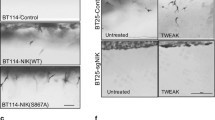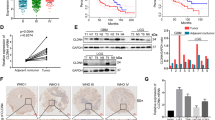Abstract
Matrix metalloproteinase 3 (MMP-3) is implicated in the pathogenesis and progression of glioma. However, whether MMP-3 participates in the regulation of metastasis and its mechanisms in glioma is mostly unknown. In the present study, glioma cells were stably transfected with Bmi-1 small interfering RNA (siRNA) to knockdown off Bmi-1 or were transiently transfected with Bmi-1 complementary DNA (cDNA) to upregulate the Bmi-1 level and to evaluate their effects on invasion and expression analysis for molecules involved in invasion. Knockdown of Bmi-1 dramatically reduced a nuclear factor kappa B (NF-κB) and MMP-3 expression and activity in T98G cells. When the T98G cells were upregulated in the Bmi-1 levels, the T98G cells were treated with 10 μM BAY 11-7028 to inhibit the NF-κB activity. The invasion induced by upregulation of Bmi-1 was severely abolished by BAY 11-7028 in Bmi-1 overexpression cells. The T98G cell metastatic potential was increased by overexpression of Bmi-1; completely at the same time, the NF-κB activity and MMP-3 expression was also increased. Taken together, these findings suggest that Bmi-1 promotes glioma cell migration and invasion via NF-κB-mediated upregulation of MMP-3.




Similar content being viewed by others
References
Kleihues P, Cavenee WK. Pathology and genetics: tumours of the nervous system. Lyon: International Agency for Research on Cancer; 2000.
Wen PY, Kesari S. Malignant gliomas in adults. N Engl J Med. 2008;59:492–507.
Furnari FB, Fenton T, Bachoo RM, Mukasa A, Stommel JM, Stegh A, et al. Malignant astrocytic glioma: genetics, biology, and paths to treatment. Genes Dev. 2007;21:2683–710.
Brinckerhoff CE, Matrisian LM. Matrix metalloproteinases: a tail of a frog that became a prince. Nat Rev Mol Cell Biol. 2002;3:207–14.
Lynch CC, Matrisian LM. Matrix metalloproteinases in tumor-host cell communication. Differentiation. 2002;70:561–73.
Friedl P, Wolf K. Tumour-cell invasion and migration: diversity and escape mechanisms. Nat Rev Cancer. 2003;3:362–74.
Matrisian LM. Metalloproteinases and their inhibitors in matrix remodeling. Trends Genet. 1990;6(4):121–5.
Bond M, Baker AH, Newby AC. Nuclear factor kappaB activity is essential for matrix metalloproteinase-1 and -3 upregulation in rabbit dermal fibroblasts. Biochem Biophys Res Commun. 1999;264(2):561–7.
Bond M, Chase AJ, Baker AH, Newby AC. Inhibition of transcription factor NF-kappaB reduces matrix metalloproteinase-1, -3 and -9 production by vascular smooth muscle cells. Cardiovasc Res. 2001;50(3):556–65.
Chase AJ, Bond M, Crook MF, Newby AC. Role of nuclear factor-kappa B activation in metalloproteinase-1, -3, and -9 secretion by human macrophages in vitro and rabbit foam cells produced in vivo. Arterioscler Thromb Vasc Biol. 2002;22(5):765–71.
Bondeson J, Lauder S, Wainwright S, Amos N, Evans A, Hughes C, et al. Adenoviral gene transfer of the endogenous inhibitor IkappaBalpha into human osteoarthritis synovial fibroblasts demonstrates that several matrix metalloproteinases and aggrecanases are nuclear factor-kappaB-dependent. J Rheumatol. 2007;34(3):523–33.
Hayry V, Tynninen O, Haapasalo HK, Wolfer J, Paulus W, Hasselblatt M, et al. Stem cell protein BMI-1 is an independent marker for poor prognosis in oligodendroglial tumours. Neuropathol Appl Neurobiol. 2008;34:555–63.
Tirabosco R, De MG, Skrap M, Falconieri G, Pizzolitto S. Expression of the Polycomb-Group protein BMI1 and correlation with p16 in astrocytomas an immunohistochemical study on 80 cases. Pathol Res Pract. 2008;204:625–31.
Valk-Lingbeek ME, Bruggeman SW, van Lohuizen M. Stem cells and cancer; the polycomb connection. Cell. 2004;118:409–18.
Jiang L, Wu J, Yang Y, Liu L, Song L, Li J, et al. Bmi-1 promotes the aggressiveness of glioma via activating the NF-kappaB/MMP-9 signaling pathway. BMC Cancer. 2012;12:406.
Song LB, Zeng MS, Liao WT, Zhang L, Mo HY, Liu WL, et al. Bmi-1 is a novel molecular marker of nasopharyngeal carcinoma progression and immortalizes primary human nasopharyngeal epithelial cells. Cancer Res. 2006;66:6225–32.
Livak KJ, Schmittgen TD. Analysis of relative gene expression data using real-time quantitative PCR and the 2(-delta delta C(T)) method. Methods. 2001;25:402–8.
Cheng SM, Xing B, Li JC, Cheung BK, Lau AS. Interferon-gamma regulation of TNFalpha-induced matrix metalloproteinase 3 expression and migration of human glioma T98G cells. Int J Cancer. 2007;121(6):1190–6.
Souslova V, Townsend PA, Mann J, van der Loos CM, Motterle A, D’Acquisto F, et al. Allele-specific regulation of matrix metalloproteinase-3 gene by transcription factor NFkappaB. PLoS ONE. 2010;5(3):e9902.
Li J, Gong LY, Song LB, Jiang LL, Liu LP, Wu J, et al. Oncoprotein Bmi-1 renders apoptotic resistance to glioma cells through activation of the IKK-nuclear factor-kappaB pathway. Am J Pathol. 2011;176:699–709.
Algül H, Adler G, Schmid RM. NF-kappaB/Rel transcriptional pathway: implications in pancreatic cancer. Int J Gastrointest Cancer. 2002;31:71–8.
Arlt A, Gehrz A, Müerköster S, Vorndamm J, Kruse ML, Fölsch UR, et al. Role of NF-kappaB and Akt/PI3K in the resistance of pancreatic carcinoma cell lines against gemcitabine-induced cell death. Oncogene. 2003;22:3243–51.
Müerköster S, Arlt A, Witt M, Gehrz A, Haye S, March C, et al. Usage of the NF-kappaB inhibitor sulfasalazine as sensitizing agent in combined chemotherapy of pancreatic cancer. Int J Cancer. 2003;104:469–76.
Sclabas GM, Fujioka S, Schmidt C, Evans DB, Chiao PJ. NF-kappaB in pancreatic cancer. Int J Gastrointest Cancer. 2003;33:15–26.
Jiang L, Song L, Wu J, Yang Y, Zhu X, Hu B, et al. Bmi-1 promotes glioma angiogenesis by activating NF-κB signaling. PLoS ONE. 2013;8(1):e55527.
He CS, Wilhelm SM, Pentland AP, Marmer BL, Grant GA, Eisen AZ, et al. Tissue cooperation in a proteolytic cascade activating human interstitial collagenase. Proc Natl Acad Sci U S A. 1989;86:2632–6.
Ogata Y, Enghild JJ, Nagase H. Matrix metalloproteinase 3 (stromelysin) activates the precursor for the human matrix metalloproteinase 9. J Biol Chem. 1992;267:3581–4.
Knauper V, Lopez-Otin C, Smith B, Knight G, Murphy G. Biochemical characterization of human collagenase-3. J Biol Chem. 1996;271:1544–50.
Acknowledgments
The project was supported by the Natural Science Foundation of Heilongjiang Province, China (Grant No. 201110).
Author information
Authors and Affiliations
Corresponding author
Additional information
Piyun Sun and Yulong Mu contributed equally to this work.
Rights and permissions
About this article
Cite this article
Sun, P., Mu, Y. & Zhang, S. A novel NF-κB/MMP-3 signal pathway involves in the aggressivity of glioma promoted by Bmi-1. Tumor Biol. 35, 12721–12727 (2014). https://doi.org/10.1007/s13277-014-2597-2
Received:
Accepted:
Published:
Issue Date:
DOI: https://doi.org/10.1007/s13277-014-2597-2




